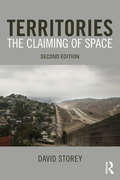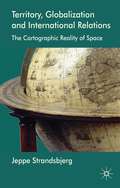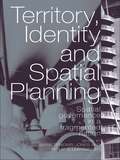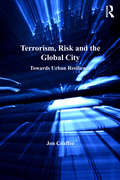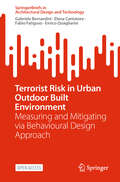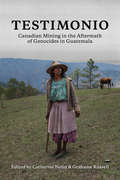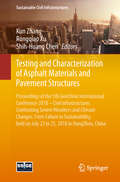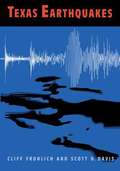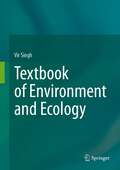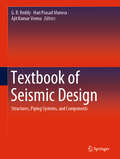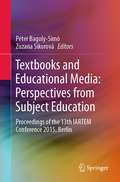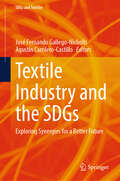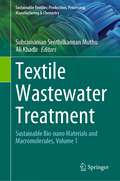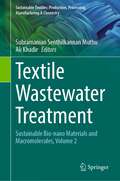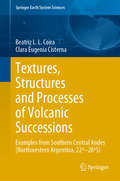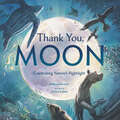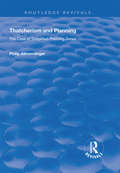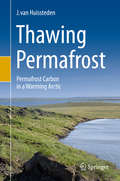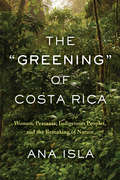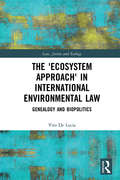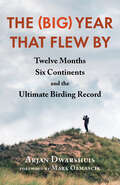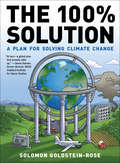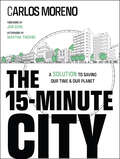- Table View
- List View
Territories: The Claiming of Space (Elgar Research Agendas Ser.)
by David StoreyPolitics and political relationships underpin the world we live in. From the division of the earth’s surface into separate states to the placement of ‘keep out’ signs, territorial strategies to control geographic space can be used to assert, maintain or resist power and as a force for oppression or liberation. Forms of exclusion can be consolidated and reinforced through territorial practices, yet they can also be resisted through similar means. Territoriality can be seen as the spatial expression of power, with borders dividing those inside from those outside. The extensively revised and updated second edition continues to provide an introduction to theories of territoriality and the outcomes of territorial control and resistance. It explores the construction of territories and the conflicts which often result using a range of examples drawn from various spatial scales and from many different countries. It ranges in coverage from conflicts over national territory (such as Israel/Palestine, Northern Ireland, South Ossetia) to divisions of space based around class, gender and race. While retaining the key elements of the first edition, this new edition covers contemporary debates on nationalism, territorialization, globalization and borders. It updates the factual content to explore the territorial consequences of ‘9/11’, the ‘war on terror’ and the conflicts in Iraq and Afghanistan. It also examines migration, refugees, the territorial expansion of the European Union, and territorial divisions in the home and workplace. The book emphasizes the underlying processes associated with territorial strategies and raises important questions relating to place, culture and identity. Key questions emerge concerning geographic space, who is ‘allowed’ to be in particular spaces and who is barred, discouraged or excluded. Written from a geographical perspective, the book is inter-disciplinary, drawing on ideas and material from a range of academic disciplines including, history, political science, sociology, international relations, cultural studies. Each chapter contains boxed case studies, illustrations and guides to further reading.
Territory, Globalization and International Relations
by Jeppe StrandsbjergGlobalization and changes to statehood challenge our understanding of space and territory. This book argues that we must understand that both the modern state and globalisation are based on a cartographic reality of space. In consequence, claims that globalization represents a spatial challenge to state territory are deeply problematic.
Territory, Identity and Spatial Planning: Spatial Governance in a Fragmented Nation
by Philip Allmendinger Mark Tewdwr-JonesThis book provides a multi-disciplinary study of territory, identity and space in a devolved UK, through the lens of spatial planning. It draws together leading internationally renowned researchers from a variety of disciplines to address the implications of devolution upon spatial planning and the rescaling of UK politics. Each contributor offers a different perspective on the core issues in planning today in the context of New Labour’s regional project, particularly the government’s concern with business competitiveness, and key themes are illustrated with important case studies throughout.
Terrorism, Risk and the Global City: Towards Urban Resilience
by Jon CoaffeeFirst published in 2003, this account of the anti-terrorist measures of London's financial district and the changes in urban security after 9/11 has been revised to take into account developments in counter-terrorist security and management, particularly after the terrorist attack in London on July 7th 2005. It makes a valuable addition to the current debate on terrorism and the new security challenges facing Western nations. Drawing on the post-9/11 academic and policy literature on how terrorism is reshaping the contemporary city, this book explores the changing nature of the terrorist threat against global cities in terms of tactics and targeting, and the challenge of developing city-wide managerial measures and strategies. Also addressed is the way in which London is leading the way in developing best practice in counter-terrorist design and management, and how such practice is being internationalized.
Terrorist Risk in Urban Outdoor Built Environment: Measuring and Mitigating via Behavioural Design Approach (SpringerBriefs in Architectural Design and Technology)
by Gabriele Bernardini Fabio Fatiguso Enrico Quagliarini Elena CantatoreThis open access book outlines the latest results in analysing, assessing, and managing terrorist risk in the urban outdoor built environment. In detail, contents refer to the outdoor Open Areas (such as streets, squares, urban parks and other public spaces in our cities) exposed to such violent events considering the physical elements and properties of the built environment and users. PThe built environment features, including layout, use and management, are combined with terrorist threats issues and user behaviours in emergency conditions, to determine a set of complementary tools for the reduction of risk and increase of urban resilience. The contents hence provide different levels of tool analysis, for risk scenario definition, risk assessment, mitigation strategies design and effectiveness evaluation, considering traditional approaches about the issue along with simulation-based approaches relying on understanding and representing user behaviors. This “behavioural design” approach offers the opportunity to manage the level of risk for specific real urban cases over going the normative limitations in Europe that are only referred to few countries and sometimes deal with the prevention of violent acts by intelligence activities as the exclusive way to face this issue. In addition, the focus on the characters of cultural and historic places and their resilience is increasing by means of introduction of mitigation and compatible solutions providing a complementary chapter for the design of resilient cities in all of their peculiarities (peripheries, consolidated, and historical). In this sense, it is one of the first organized attempts to analyse the main limitations of current solutions in these outdoor Open Areas and, at the same time, to clearly introduce the importance of human behaviours and the various choices in emergency evacuation conditions, thanks to the proposed behavioural-based simulation approach. The attention is focused on a critical aspect for historic spaces, where morphological conditions are fixed values. Thus, this book represents a sort of guidelines about these user-related issues during such violent events and is useful to both professionals and researchers in the areas of security and urban administration.
Testimonio: Canadian Mining in the Aftermath of Genocides in Guatemala
by Catherine Nolin Grahame RussellWhat is land? A resource to be exploited? A commodity to be traded? A home to cherish? In Guatemala, a country still reeling from thirty-six years of US-backed state repression and genocides, dominant Canadian mining interests cash in on the transformation of land into “property,” while those responsible act with near-total impunity. Editors Catherine Nolin and Grahame Russell draw on over thirty years of community-based research and direct community support work in Guatemala to expose the ruthless state machinery that benefits the Canadian mining industry—a staggeringly profitable juggernaut of exploitation, sanctioned and supported every step of the way by the Canadian government. This edited collection calls on Canadians to hold our government and companies fully to account for their role in enabling and profiting from violence in Guatemala. The text stands apart in featuring a series of unflinching testimonios (testimonies) authored by Indigenous community leaders in Guatemala, as well as wide-ranging contributions from investigative journalists, scholars, lawyers, activists, and documentarians on the ground. As resources are ripped from the earth and communities and environments ripped apart, the act of standing in solidarity and bearing witness—rather than extracting knowledge—becomes more radical than ever.
Testing and Characterization of Asphalt Materials and Pavement Structures: Proceedings of the 5th GeoChina International Conference 2018 – Civil Infrastructures Confronting Severe Weathers and Climate Changes: From Failure to Sustainability, held on July 23 to 25, 2018 in HangZhou, China (Sustainable Civil Infrastructures)
by Kun Zhang Rongqiao Xu Shih-Huang ChenThis book presents new studies dealing with the attempts made by the scientists and practitioners to address contemporary issues in pavement engineering such as aging and modification of asphalt binders, performance evaluation of warm mix asphalt, and mechanical-based pavement structure analysis, etc.. Asphalt binder and mixture have been widely used to construct flexible pavements. Mechanical and Chemical characterizations of asphalt materials and integration of these properties into pavement structures and distresses analysis are of great importance to design a sustainable flexible pavement. This book includes discusses and new results dealing with these issues. Papers were selected from the 5th GeoChina International Conference 2018 – Civil Infrastructures Confronting Severe Weathers and Climate Changes: From Failure to Sustainability, held on July 23 to 25, 2018 in HangZhou, China.
Tewkesbury Walks
by Bernard MichauxThe book is composed of eight chapters, each of which are organised as walks around the Tewkesbury (UK) countryside, which move from the specific to increasingly broader ideas. So, the MS starts with an individual's relationship to their environment (Avon and Severn Valleys Loop) that leads to a description of conservation issues at local, national and international levels, and ultimately to a discussion of the importance of Citizen Science (Coombe Hill - Apperley -Deerhurst). The following chapter (Mythe Bridge - Forthampton - Tewkesbury) looks at science as it is actually practiced and its role in modern society by an analysis of the theory of Continental Drift and a biography of Alfred Wegener. This is a story that really deserves a much wider audience, as the idea was, in my opinion, as revolutionary as general relativity or quantum mechanics, and Wegener himself was such a heroic character. The following chapter (Tewkesbury Ham) also uses biography - this time of Alfred Russel Wallace - to investigate his ideas about how animal and plant distributions are inextricably linked to geological change. Wallace was every bit as heroic as Wegener, lived an even more adventurous life, and also deserves to be more widely known and appreciated. 2013 is the centenary of his death and he will be much in the news this year, so it would be timely to publish an account of his life and work suitable for the general public. The chapters on Wegener and Wallace set the scene for a detailed discussion of biogeography. This has been an active area of research for the past 30 years and I think it's about time that somebody wrote about what has been an intellectually exciting and profoundly significant development in our view of ourselves and the world we live in.
Texas Earthquakes
by Cliff Frohlich Scott D. DavisWhen nature goes haywire in Texas, it isn't usually an earthshaking event. Though droughts, floods, tornadoes, and hail all keep Texans talking about the unpredictable weather, when it comes to earthquakes, most of us think we're on terra firma in this state. But we're wrong! Nearly every year, earthquakes large enough to be felt by the public occur somewhere in Texas. <P><P> This entertaining, yet authoritative book covers "all you really need to know" about earthquakes in general and in Texas specifically. The authors explain how earthquakes are caused by natural forces or human activities, how they're measured, how they can be predicted, and how citizens and governments should prepare for them. They also thoroughly discuss earthquakes in Texas, looking at the occurrences and assessing the risks region by region and comparing the amount of seismic activity in Texas to other parts of the country and the world. The book concludes with a compendium of over one hundred recorded earthquakes in Texas from 1811 to 2000 that briefly describes the location, timing, and effects of each event.
Texas Science (Grade #7)
by Cpo Science-Science and Living Systems <p><p> -Matter, Energy, and Cells <p> -Matter, Energy, and Ecosystems <p> -Organisms and Change <p> -Human Body Structure and Function
Textbook of Environment and Ecology
by Vir SinghThis textbook is focused on fundamentals of environment and ecology for undergraduate and graduate students. This is first of its kind book dealing with physical environment, ecosystems, biological diversity, environmental pollution, and environment-influenced natural resource ecology and management. This will cater to the needs of the students, examinees, trainees, and teachers. It consists of 23 chapters spread over 5 sections i.e., ecosystem analysis, natural resources, biodiversity, environmental disruptions, and environmental management. The textbook is well aligned with the syllabus of all central and state universities and offers the latest insights as well to the students of undergraduate and postgraduate courses of ecology and environmental sciences. Every chapter provides summary/points to remember and exercises. Each exercise includes 20 multiple-choice questions, 10 short-answer questions, and 5 long-answer questions. The textbook is a comprehensive coverage for basic and advanced courses in ecology and environmental sciences. Each topic is supported by illustrations, tables, and information boxes etc.
Textbook of Seismic Design: Structures, Piping Systems, and Components
by Ajit Kumar Verma Hari Prasad Muruva G. R. ReddyThis book focuses on the seismic design of Structures, Piping Systems and Components (SSC). It explains the basic mechanisms of earthquakes, generation of design basis ground motion, and fundamentals of structural dynamics; further, it delves into geotechnical aspects related to the earthquake design, analysis of multi degree-of-freedom systems, and seismic design of RC structures and steel structures. The book discusses the design of components and piping systems located at the ground level as well as at different floor levels of the structure. It also covers anchorage design of component and piping system, and provides an introduction to retrofitting, seismic response control including seismic base isolation, and testing of SSCs. The book is written in an easy-to-understand way, with review questions, case studies and detailed examples on each topic. This educational approach makes the book useful in both classrooms and professional training courses for students, researchers, and professionals alike.
Textbooks and Educational Media: Proceedings of the 13th IARTEM Conference 2015, Berlin
by Péter Bagoly-Simó Zuzana SikorováThis book brings together empirical research and conceptual work on textbooks and education media from 13 countries and 17 disciplines. Along with textbook production, usage, and development, it also explores the interconnectedness of (educational) policy and teaching and learning materials. Further, the book offers insights into regional and local discourses (e.g. specific theories of Portuguese- and Spanish-speaking countries as well as Nordic countries, contrasting their theories with international literature), practices, and solutions with regard to teaching selected subjects at the pre-primary, primary, secondary, and tertiary level. This book also discusses the specific combinations of subjects (e.g. Physics, Biology, Geography, Swedish, English) and their subject-specific education (e.g. Physics Education or Didactics). Lastly, it examines the work of a number of early-career researchers, giving them a voice and bringing in fresh ideas currently being developed in various countries around the globe.This proceedings volume will appeal to publishers, subject educators in primary, secondary, and tertiary education, and academic researchers from the fields of textbooks, educational media and subject-specific education. Its international authorship and explicit focus on subject-specific particularities of educational media provide a unique and comprehensive overview.
Textile Industry and the SDGs: Exploring Synergies for a Better Future (SDGs and Textiles)
by José Fernando Gallego-Nicholls Agustín Carrilero-CastilloThis book offers an exploration of the textile industry and their relationship to the Sustainable Development Goals (SDGs), catering specifically to academic researchers and providing a roadmap for aligning aligning textile research with the SDGs. It covers a wide range of topics, starting with an overview of the SDGs and their relevance to the textile industry. It examines the environmental footprint of textiles, including issues related to raw material sourcing, manufacturing processes, and waste management. Additionally, it explores the social and economic aspects of textiles, such as labor conditions, fair trade, and responsible consumption. One of the main focuses of this book is the role of innovation and technology in advancing sustainable textiles. It discusses emerging materials and technologies that promote circularity, reduce environmental harm, and enhance social well-being. Furthermore, it explores the potential of digitalization, artificial intelligence, and data analytics in optimizing textile production, distribution, and consumption patterns. This book also addresses the challenges and opportunities associated with sustainable textile supply chains. It analyzes the complexities of global value chains, the need for transparency and traceability, and the importance of collaboration among stakeholders. Furthermore, it highlights strategies for promoting sustainable fashion, encouraging responsible consumption, and fostering circular business models. By delving into these topics, this book aims to solve several key problems faced by academic researchers in the field of textiles and sustainability. It provides a holistic understanding of the SDGs and their integration into textile research, helping researchers align their work with broader sustainability objectives. It offers insights into the latest innovations and technologies, enabling researchers to explore cutting-edge solutions for sustainable textiles. Additionally, it presents case studies and best practices from industry leaders, inspiring researchers to undertake impactful research and contribute to positive change. This book is intended for academic researchers, as well as practitioners, specializing in textiles, sustainability, and related fields. It serves as a valuable resource for professors, postgraduate students, and professionals seeking to deepen their knowledge of the interplay between textiles and the SDGs. It encourages critical thinking, fosters interdisciplinary collaboration, and equips researchers with the tools and insights necessary to drive sustainable transformations within the textile industry and beyond.
Textile Wastewater Treatment: Sustainable Bio-nano Materials and Macromolecules, Volume 1 (Sustainable Textiles: Production, Processing, Manufacturing & Chemistry)
by Subramanian Senthilkannan Muthu Ali KhadirIn this first volume, various materials such as chitosan, lignin-based biomaterials, cellulosic based bio materials, carbon materials, Polysaccharide-composites materials, Aromatic-Based Synthetic Macromolecules, Agricultural wastes, etc for treating textile waste water are highlighted. One of the major pollutants in the textile and fashion industry is (textile) waste water. Textile wastewater can lead to serious environmental issues if discharged without proper and sufficient treatment. The materials employed along with the technologies available to trate waste water are the key. There are a lot of advancements in terms materials, technologies employed for textile waste water treatment. Sustainable bio-nano materials and macro molecules play a major role in the efficient treatment of textile waster.
Textile Wastewater Treatment: Sustainable Bio-nano Materials and Macromolecules, Volume 2 (Sustainable Textiles: Production, Processing, Manufacturing & Chemistry)
by Subramanian Senthilkannan Muthu Ali KhadirIn this second volume, various materials such as Magnetic-based biocomposites, wheat bran/straw-based biomaterials, peel-based biomaterials, luffa Based Biomaterials, composite polymeric membranes, rice husk, hydroxyapatite etc for treating textile waste water are highlighted. One of the major pollutants in the textiles and fashion sector is textile waste water. Textile wastewater can lead to serious environmental issues if discharged without proper and sufficient treatment. The materials employed along with the technologies available to trate the waste water are the key. There are a lot of advancements in terms materials, technologies employed for textile waste water treatment. Sustainable bio-nano materials and macro molecules play a major role in the efficient textile waste treatment.
Textures, Structures and Processes of Volcanic Successions: Examples from Southern Central Andes (Northwestern Argentina, 22º–28ºS) (Springer Earth System Sciences)
by Beatriz L.L. Coira Clara Eugenia CisternaThis book provides a complete study of the Central Andean volcanism and its most distinctive features, from the lower Paleozoic to the Cenozoic times in the framework of its processes, eruptive mechanisms and geodynamic conditions.It helps readers understand the nature of the volcanic geology and the volcaniclastic related deposits linked to the evolution of the Andean continental margin. Special attention is paid to the analysis of the ancient volcanic successions and the difficulties in recognition of the original rock type caused by the effects of deformation, metamorphism and alteration. The authors use distinctive cases to describe how to apply different tools in analysis and interpretation. The selected representative, well exposed and preserved volcanic records of the Southern Central Andes analyzed in this book open new perspectives in the understanding of the volcanic processes linked to active continental margins as the Central Andes.This book will be of special interest to volcanologists and specialists in the earth sciences and appeal to both undergraduate and graduate students in geology.
Thank You, Moon: Celebrating Nature's Nightlight
by Melissa StewartWith the soothing rhythm of a bedtime story and the scientific wonder of a nature doc, comes a celebration of the moon and all the creatures who rely on its light to find their way home.Under the glow of a shimmering moon, creatures great and small creep out of their dens, using its light to hunt, fend off predators, build their nests or build families. As the moon changes phases these animals adapt their behavior to match its waxing and waning—while human animals look on in wonder.As Earth's closest companion in space, the moon has fascinated humankind for generations, and this nonfiction picture book sheds light on the mysterious ways it affects life on Earth. With luminous illustrations by Jessica Lanan and a lyrical text that is part lullaby and part scientific resource, Thank You, Moon is a treasure for all ages to enjoy.
Thatcherism and Planning: The Case of Simplified Planning Zones (Routledge Revivals)
by Philip M. AllmendingerFirst published in 1997, this volume explores how, seventeen years after the election of the first Thatcher government, it is clear that despite the attacks, land use planning has survived. Talk during the 1980s of the death of planning and a bonfire of controls seem in hindsight distant and alarmist. Planning now has a new lease of life and is once again firmly on the government’s agenda. So what happened during the 1980s? How did planning come to experience such a radical change in fortune? Philip Allmendinger explores the impact and influence of the New Right’s intentions for planning through arguably the most Thatcherite approach of all: Simplified Planning Zones (SPZs). In doing so he identifies the contradictions and confusion at the heart of Thatcherism that led to vague legislation and objectives allowing localities to interpret Thatcherism for themselves often using policies such as SPZs for reasons very different than those intended.
Thawing Permafrost: Permafrost Carbon in a Warming Arctic
by J. van HuisstedenThis book provides a cross-disciplinary overview of permafrost and the carbon cycle by providing an introduction into the geographical distribution of permafrost, with a focus on the distribution of permafrost and its soil carbon reservoirs. The chapters explain the basic physical properties and processes of permafrost soils: ice, mineral and organic components, and how these interact with climate, vegetation and geomorphological processes. In particular, the book covers the role of the large quantities of ice in many permafrost soils which are crucial to understanding carbon cycle processes.An explanation is given on how permafrost becomes loaded with ice and carbon. Gas hydrates are also introduced. Structures and processes formed by the intense freeze-thaw action in the active layer are considered (e.g. ice wedging, cryoturbation), and the processes that occur as the permafrost thaws, (pond and lake formation, erosion).The book introduces soil carbon accumulation and decomposition mechanisms and how these are modified in a permafrost environment. A separate chapter deals with deep permafrost carbon, gas reservoirs and recently discovered methane emission phenomena from regions such as Northwest Siberia and the Siberian yedoma permafrost.
The "Greening" of Costa Rica: Women, Peasants, Indigenous Peoples, and the Remaking of Nature
by Ana IslaSince the 1992 Earth Summit in Rio de Janeiro, the concept of sustainable development has become the basis for a vast number of "green industries" from eco-tourism to carbon sequestration. <P><P>In The "Greening" of Costa Rica, Ana Isla exposes the results of the economist's rejection of physical limits to growth, the biologist's fetish with such limits, and the indebtedness of peripheral countries. <P><P>Isla's case study is the 250,000 hectare Arenal-Tilaran Conservation Area, created in the late 1990s as the result of Canada-Costa Rica debt-for-nature swaps. <P><P> Rather than reducing poverty and creating equality, development in and around the conservation area has dispossessed and disenfranchised subsistence farmers, expropriating their land, water, knowledge, and labour. <P><P>Drawing on a decade of fieldwork in these communities, Isla exposes the duplicity of a neoliberal model in which the environment is converted into commercial assets such as carbon credits, intellectual property, cash crops, open-pit mining, and eco-tourism, few of whose benefits flow to the local population.
The 'Ecosystem Approach' in International Environmental Law: Genealogy and Biopolitics (Law, Justice and Ecology)
by Vito De LuciaThe ecosystem approach, broadly understood as a legal and governance strategy for integrated environmental and biodiversity management, has been adopted within a wide variety of international environmental legal regimes and provides a narrative, a policy approach and in some cases legally binding obligations for States to implement what has been called a ‘new paradigm’ of environmental management. In this last respect, the ecosystem approach is also often considered to offer an opportunity to move beyond the outdated anthropocentric framework underpinning much of international environmental law, thus helping re-think law in the Anthropocene. Against this background, this book addresses the question of whether the ecosystem approach represents a paradigm shift in international environmental law and governance, or whether it is in conceptual and operative continuity with legal modernity. This central question is explored through a combined genealogical and biopolitical framework, which reveals how the ecosystem approach is the result of multiple contingencies and contestations, and of the interplay of divergent and sometimes irreconcilable ideological projects. The ecosystem approach, this books shows, does not have a univocal identity, and must be understood as both signalling the potential for a decisive shift in the philosophical orientation of law and the operationalisation of a biopolitical framework of control that is in continuity with, and even intensifies, the eco-destructive tendencies of legal modernity. It is, however, in revealing this disjunction that the book opens up the possibility of moving beyond the already tired assessment of environmental law through the binary of anthropocentrism and ecocentrism.
The (Big) Year that Flew By: Twelve Months, Six Continents, and the Ultimate Birding Record
by Arjan Dwarshuis&“A fast-paced page-turner and a unique adventure story . . . filled with insights about landscapes, people, and a world of wonderful birds.&”―Kenn Kaufman, author of Kingbird HighwayAn epic tale of one passionate birder&’s record-breaking adventure through 40 countries over 6 continents—in just one year—to see 6,852 bird species, rare and common, before many go extinct.When Arjan Dwarshuis first heard of the &“Big Year&”—the legendary record for birdwatching—he was twenty years old, it was midnight, and he was sitting on the roof of a truck in the Andean Mountains. In that moment he promised himself that, someday, somehow, he would become a world-record-holding birder.Ten years later, he embarked on an incredible, arduous, and perilous journey that took him around the globe; over uninhabited islands, through dense unforgiving rainforests, across snowy mountain peaks and unrelenting deserts—in just a single year. Would he survive? Would he be able to break the &“Big Year&” record, navigating through a world filled with shifting climate and geopolitical challenges?The (Big) Year that Flew By is an unforgettable, personal exploration of the limits of human potential when engaging with the natural world. It is a book about birds and birding and Arjan&’s attempts to raise awareness for critically endangered species, but it is also a book about overcoming mental challenges, extreme physical danger, and human competition and fully realizing your passions through nature, adventure, and conservation.&“Dwarshius&’ exhilarating race against time across 40 countries and 6 continents in his attempt to break the world record will thrill armchair readers and bird enthusiasts alike.&”―Booklist&“I sped through [this] book, trying to ignore feelings of jealousy as Dwarshuis described moments with species I&’ve dreamed of seeing.&”—The Washington Post
The 100% Solution: A Plan for Solving Climate Change
by Solomon Goldstein-Rose"At last--a global plan that actually adds up."--James Hansen, former director, NASA Goddard Institute for Space StudiesThe world must reach negative greenhouse gas emissions by 2050 to avoid the most catastrophic effects of climate change. Yet no single plan has addressed the full scope of the problem--until now. In The 100% Solution, Solomon Goldstein-Rose--a leading millennial climate activist and a former Massachusetts state representative--makes clear what needs to happen to hit the 2050 target: the manufacturing booms we must spur, the moonshot projects we must fund, the amount of CO2 we'll have to sequester from the atmosphere, and much more. Most importantly, he shows us the more prosperous and equitable world we can build by uniting the efforts of activists, industries, governments, scientists, and voters to get the job done. This is the guide we've been waiting for. As calls for a WWII-scale mobilization intensify--especially among youth activists--this fully illustrated, action-oriented book arms us with specific demands, sets the stakes for what our leaders must achieve, and proves that with this level of comprehensive thinking we can still take back our future.
The 15-Minute City: A Solution to Saving Our Time and Our Planet
by Carlos MorenoA fresh and innovative perspective on urban issues and creating sustainable cities In The 15-Minute City: A Solution for Saving Our Time and Our Planet, human city pioneer and international scientific advisor Carlos Moreno delivers an exciting and insightful discussion of the deceptively simple and revolutionary idea that everyday destinations like schools, stores, and offices should only be a short walk or bike ride away from home. This book tells the story of an idea that spread from city to city, describing a new way of looking at living that addresses many of the most intractable challenges of our time. Hundreds of mayors worldwide have already embraced the concept as a way to help recover from the pandemic, and the idea continues to gain speed. You'll learn why more and more cities are planning to make cars far less necessary for contemporary city-dwellers and how they're planning to achieve that goal. You'll also find: Strategies for cities to recover and adapt to benefit residents, saving them precious time Techniques to change the habits of automobile-dependent city residents and maximize social benefits of living in a human-centric city Scientifically developed, research-backed solutions for enduring urban issues and problems Deeply committed to science, progress, and creativity, Moreno presents an essential and timely resource in The 15-Minute City, which will prove invaluable to anyone with an interest in modern and innovative approaches to consistently challenging urban issues that have bedeviled policy makers and city residents since the invention of the car.
